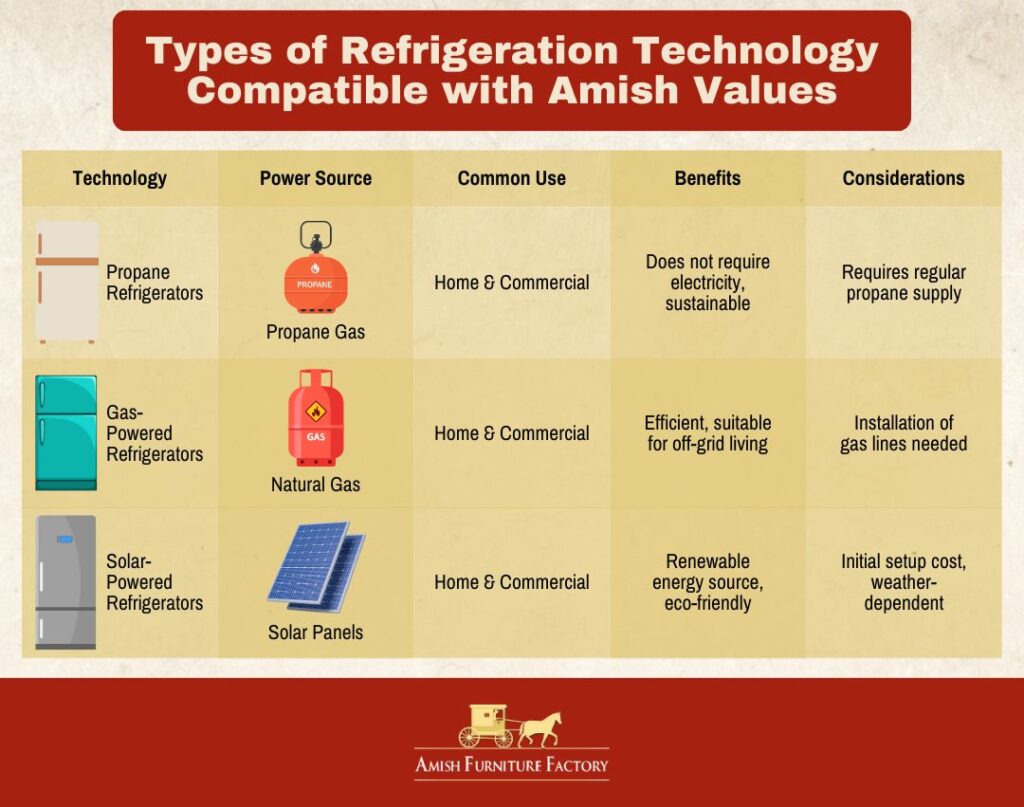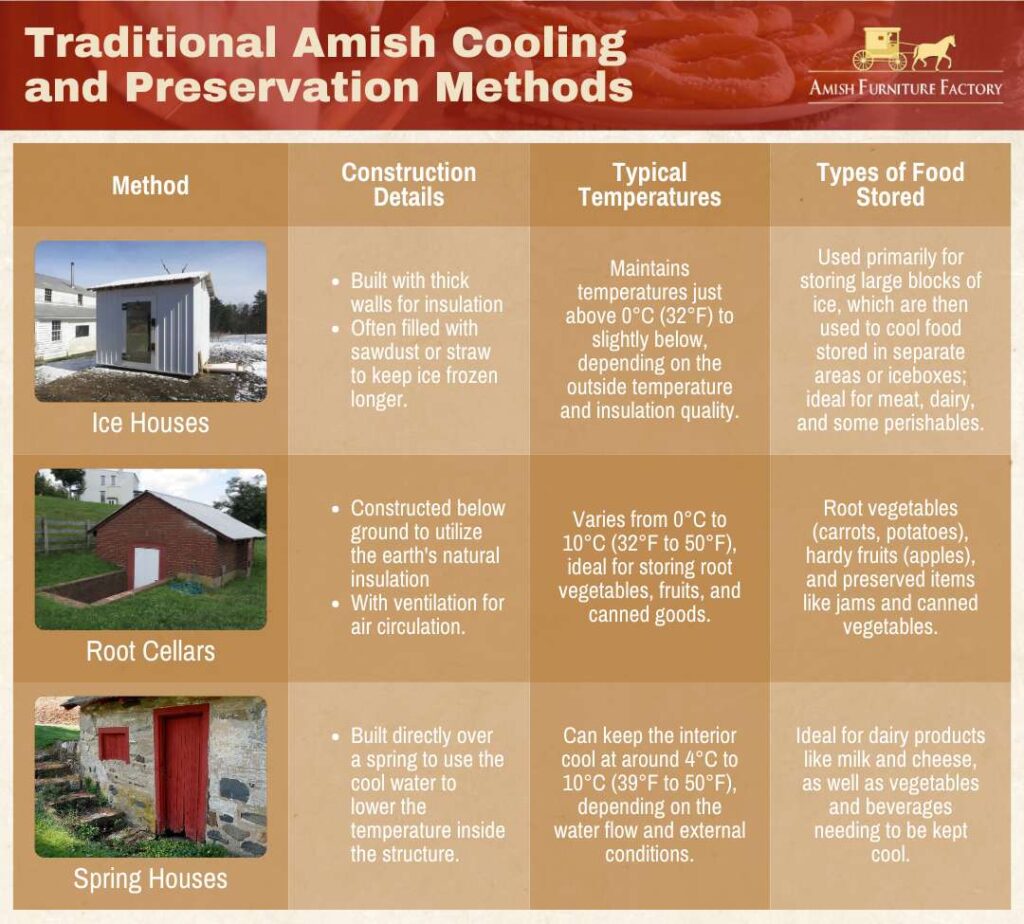
In the heart of Amish country, the clash between tradition and modernity takes on unique forms, especially regarding refrigeration. Amidst a lifestyle that values simplicity, the Amish navigate the complexities of keeping food fresh in ways that might surprise you.
Amish communities use gas-powered and solar-powered refrigerators in their homes, embracing tradition and modern needs. They also have other food cooling and preservation methods like ice houses, spring houses, root cellars, canning, drying/dehydrating, smoking/salting, and fermentation.
Explore the ingenuity of Amish refrigeration practices and how they blend traditional values with contemporary solutions for food preservation.
Understanding Amish Technology Use
The Amish approach to technology is deeply rooted in their commitment to modesty, community, and separation from the wider world. This ethos guides their selective use of modern conveniences, balancing necessity with tradition.
Avoidance of Grid Electricity
Many Amish communities prohibit connection to public electric utilities to maintain separation from the outside world and encourage self-sufficiency. This rule helps avoid the potential for worldly influences that could disrupt community life and values.
Selective Use of Powered Equipment
Some Amish can use diesel or gas-powered equipment while avoiding grid electricity. These are mainly used for business, farming, and household needs that support the community’s self-reliant lifestyle without fostering excessive dependence on external systems.
Transportation Guidelines
Traditional Amish guidelines forbid owning and driving motor vehicles, as they encourage unnecessary travel, erode community cohesion, and increase exposure to external influences.
Communication Technologies
Fixed-line telephones are generally allowed for business purposes but are often placed in communal booths rather than individual homes to avoid intrusion into family life and community interaction. Mobile phones and the internet may be permitted for business use in some communities under strict controls to limit exposure to harmful content and maintain community values.
Home Appliances
In general, the Amish avoid the use of electricity, which means that most modern appliances such as refrigerators, microwaves, and washing machines are not utilized in Amish households. Instead, they prefer manual tools and traditional methods for daily tasks, reflecting their dedication to simplicity and self-sufficiency.
However, there are exceptions within certain Amish communities, where limited use of specific appliances powered by alternative sources such as gas or hydraulic energy may be permitted.
Educational Technologies
Generally, the Amish limit educational technologies to those directly supporting learning traditional skills and knowledge necessary for community life. High-tech devices, electronic media, and internet access are typically excluded from Amish schools to focus on basic literacy, mathematics, and vocational training.
Here are examples of technologies that some Amish communities have permitted, each tailored to fit within their strict guidelines while supporting their way of life:
- Gas-Powered Refrigerators: These refrigerators are favored because they do not require electricity from the public grid, aligning with the Amish principle of separation from society. They allow for food preservation and safety without compromising the community’s self-reliance.
- Solar Panels: Some Amish have adopted solar panels to generate limited electricity for specific purposes, such as lighting barns or powering milk coolers, without connecting to the external electric grid. This use of alternative energy is considered acceptable as it supports self-sufficiency and is used in a way that minimizes exposure to worldly influences.
- Diesel or Gas-Powered Generators: For operations that require power, such as woodworking shops or dairy farms, diesel or gas generators provide a self-contained solution. These generators enable the Amish to maintain their businesses and livelihoods while adhering to their community’s guidelines against using grid-supplied electricity.
- Hydraulic and Pneumatic Tools: Amish artisans use tools powered by hydraulic or pneumatic systems instead of electrically powered tools. These tools are essential for industries like woodworking and metalworking, allowing for efficiency and craftsmanship that support the community’s economic well-being.
- Bicycles and Scooters: Many Amish use bicycles and scooters for transportation within and around their communities. These modes of transport provide practical mobility for work and school without the societal separation associated with motor vehicles.
- LED Lighting Powered by Batteries or Solar: In homes and on farms, LED lights powered by batteries or solar panels are used to extend productive hours without reliance on the electric grid.
- Non-Electric Household Appliances: The Amish utilize various non-electric appliances, from sewing machines operated by foot pedals to hand-cranked blenders. These tools maintain the home’s functionality without grid electricity, preserving the Amish commitment to simplicity and manual labor.
Can Amish People Use Refrigerators?

Refrigeration within Amish communities reveals a fascinating blend of tradition and adaptation. The question isn’t as straightforward as a simple yes or no—it unfolds into a story of innovation and community values.
Non-Electric Refrigeration
Amish people use refrigerators, but with a twist that aligns with their commitment to avoid grid electricity. Gas-powered and solar-powered refrigerators are common in many Amish homes and businesses- we’ll talk more about them later.
These alternatives provide the necessary functionality for preserving food without breaching the community’s guidelines against connecting to the public electric grid.
Community-Shared Refrigeration Resources
This practice is more common in the most conservative Amish groups, who seek to maintain a greater distance from modern conveniences, including individual ownership of refrigerators, whether gas-powered or solar-powered.
In these communities, refrigeration resources are centralized in a communal building or a business owned by a community member. This setup allows multiple families to store perishable goods in a shared space.
In some cases, some non-Amish neighbors help out. As reported by Erik Wesner, who has been visiting Amish communities across America, “Some may also use freezer space provided by English neighbors,” “We had a neighbor come and ask if they could put a freezer inside our garage. I suggested that we put up an outdoor shed instead. I spoke with the bishop and he said it was okay so long as it was on my property,” he added.
The specifics of how these resources are shared can vary; in some cases, families might have designated times for access or specific shelves assigned to them. In other instances, the shared space operates like a community ice house or sizable walk-in refrigerator, where bulk items can be stored and accessed.
Alternatives to Electric Refrigeration in Amish Homes
The Amish have developed several innovative solutions to keep their food fresh without relying on conventional electricity, reflecting their ingenuity and commitment to plainness.

Gas-powered Refrigerators
Gas-powered Refrigerators operate on propane or natural gas, using a gas absorption cooling system. This system doesn’t require electricity; instead, it uses a gas flame to heat a refrigerant, which then circulates through the system to cool the refrigerator’s interior.
Gas refrigerators can look quite similar to their electric counterparts, featuring a familiar boxy shape with doors for refrigeration and often a separate freezer compartment. However, they might have more robust construction and are designed to be highly efficient with gas consumption.
The exterior is typically finished in white or other neutral colors, blending seamlessly into the Amish kitchen aesthetic, which favors simplicity and functionality. Inside, you’ll find shelves and compartments designed to store various foods, from dairy products and meats to fruits and vegetables, all kept fresh without relying on the electrical grid.
Solar-powered Refrigerators
Solar-powered refrigerators harness the power of the sun to keep food cool and fresh, making them an excellent fit for Amish communities focused on sustainability and independence from public utilities.
These refrigerators work by converting sunlight into electricity through solar panels, typically mounted on the roof of a home or barn. This electricity then powers a compressor that cools the refrigerator, much like a conventional electric fridge.
However, solar refrigerators are designed to be highly efficient, using minimal energy to maximize the utility of the solar power they generate.
In terms of appearance, solar-powered refrigerators can look similar to traditional models, with sleek designs that house both refrigeration and freezing compartments. They often have energy-efficient features like insulation and LED lighting to reduce power consumption.
Alternative Cooling and Preservation Methods
Beyond gas and solar-powered refrigeration, the Amish employ various traditional methods for cooling and preserving food. These techniques demonstrate a harmonious blend of practicality and adherence to Amish cultural values.

Ice Houses
Ice houses are a time-honored method the Amish use to keep food cold without electricity. Built to store ice harvested during the winter, these structures are insulated with sawdust or straw to preserve the ice for as long as possible, sometimes well into the summer months.
The stored ice is used to cool a separate storage area where food can be kept at lower temperatures, extending the freshness of perishable items like fruits, vegetables, and dairy products.
Spring Houses
Spring houses utilize natural spring water to refrigerate food. These small buildings are constructed over or adjacent to a spring, allowing the cool water to flow beneath the floor and reducing the interior temperature.
This method is especially effective for cooling dairy products and produce. Spring houses represent a natural refrigeration system, leveraging the constant temperature of groundwater to keep food fresh.
Root Cellars
Root cellars are underground rooms that use the earth’s natural insulation to store food at cool temperatures. Dug into the ground or built into the side of a hill, root cellars maintain a consistent, cool environment ideal for storing fruits, vegetables, canned goods, and even some types of meat.
The excellent, humid conditions in a root cellar are perfect for prolonging the storage life of harvests, ensuring a supply of fresh food throughout the year, even in the absence of modern refrigeration.
Amish Food Preservation Techniques
In addition to refrigeration, the Amish community employs a range of food preservation techniques that are as practical as they are steeped in tradition. These methods, essential for sustaining families through the winter months, are a testament to their resourcefulness and self-reliance.

Canning
Canning is a cornerstone of Amish food preservation, allowing various foods to be stored for long periods. The Amish typically use a water bath canning method for high-acid foods like fruits and pickles and pressure canning for low-acid foods like vegetables and meats.
This process involves sterilizing jars and lids, carefully preparing and packing food, and then processing the jars in boiling water or a pressure canner to create a vacuum seal that preserves the food.
Canning is meticulously carried out to prevent foodborne illnesses, with particular attention to sterilization and sealing processes to avoid botulism and other microbial risks. The high heat used in canning effectively kills bacteria and seals the food away from the air, making it a safe method for long-term storage of various foods.
Drying and Dehydrating
Drying or dehydrating is another traditional method the Amish use to preserve food. Fruits, vegetables, and herbs are commonly dried to extend their shelf life.
This process involves removing moisture from the food, which inhibits the growth of bacteria and mold. This method significantly reduces the risk of food spoilage and extends the shelf life of fruits, vegetables, and herbs.
Drying can be done using the sun or air. The dried foods are then stored in a cool, dry place and can be rehydrated for cooking or consumed. Properly dried foods stored in airtight containers can last months or years, retaining most of their nutritional value.
Smoking and Salting
Meats are often preserved through smoking or salting. Smoking involves curing meat with smoke from burning wood, which imparts flavor and helps preserve the meat by slowing spoilage. Salting, conversely, consists of using salt to draw moisture out of the meat.
Smoking and salting are ancient methods of preserving meat and fish that add flavor and inhibit the growth of microorganisms. Smoking introduces phenolic compounds with antimicrobial properties, while salting draws out moisture, creating an inhospitable environment for pathogens.
These methods effectively extend the usability of proteins, which is crucial in Amish diets.
Fermentation
Fermentation is a preservation method that extends the shelf life of foods and enhances their nutritional value. Common fermented Amish foods include sauerkraut, pickles, and yogurt.
Fermentation leverages beneficial bacteria to transform food, making it less susceptible to spoilage by harmful microorganisms. This process also enhances food safety by producing organic acids that suppress the growth of pathogenic bacteria.
Fermented foods are safe for long-term storage and offer health benefits, including improved digestion and immunity.
Beyond the Grid: Refrigeration in Amish Homes
The Amish approach to refrigeration, characterized by the innovative use of gas-powered and solar-powered units, reflects a broader commitment to living in harmony with their values. These alternatives address the practical need to preserve food safely and embody the Amish principles and independence from the electrical grid.
It’s a narrative that offers more than just an answer to a question; it provides insight into a simple lifestyle and a thoughtful balance between the old and the new. These Amish practices remind us of the importance of mindful consumption and the potential for communities to sustain themselves through a blend of ancient wisdom and innovations while maintaining a deep respect for the natural world and the bonds that tie them together.
